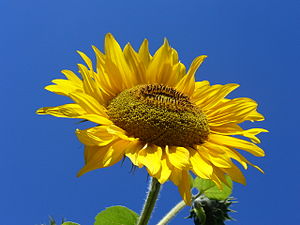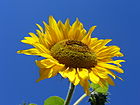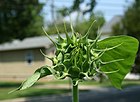Note: This is a project under development. The articles on this wiki are just being initiated and broadly incomplete. You can Help creating new pages.
Difference between revisions of "Helianthus annuus"
(→Chemical Composition) |
|||
| Line 9: | Line 9: | ||
==Chemical Composition== | ==Chemical Composition== | ||
| − | <ref name="chemical composition"/> | + | Sunflower (Helianthus Annuus) contains active Ingredients, Such as Flavonoids, Alkaloids and Tannins. <ref name="chemical composition"/> |
==Common names== | ==Common names== | ||
Revision as of 10:58, 15 October 2023
Helianthus annuus is a vigorous, Erect, Usually unbranched annual plant that can grow from 1 - 3 metres or more tall according to the variety. It usually produces a single, large flower head at the top of the stem. Sunflower is a major commercial crop, Grown widely in the tropical to warm temperate zones for its edible, Oil-rich seed.
Contents
- 1 Uses
- 2 Parts Used
- 3 Chemical Composition
- 4 Common names
- 5 Properties
- 6 Habit
- 7 Identification
- 8 List of Ayurvedic medicine in which the herb is used
- 9 Where to get the saplings
- 10 Mode of Propagation
- 11 How to plant/cultivate
- 12 Commonly seen growing in areas
- 13 Photo Gallery
- 14 References
- 15 External Links
Uses
High fever, Sores, Swellings, Snakebites, Spider bites, Malaria, Lung ailments, Pulmonary complaints, Rheumatic aches.[1]
Parts Used
Chemical Composition
Sunflower (Helianthus Annuus) contains active Ingredients, Such as Flavonoids, Alkaloids and Tannins. [3]
Common names
| Language | Common name |
|---|---|
| Kannada | Surykanti |
| Hindi | Surajmukhi |
| Malayalam | NA |
| Tamil | Surykanti |
| Telugu | Surykantamu |
| Marathi | NA |
| Gujarathi | NA |
| Punjabi | NA |
| Kashmiri | NA |
| Sanskrit | Sarymukhi |
| English | Sunflower |
Properties
Reference: Dravya - Substance, Rasa - Taste, Guna - Qualities, Veerya - Potency, Vipaka - Post-digesion effect, Karma - Pharmacological activity, Prabhava - Therepeutics.
Dravya
Rasa
Guna
Veerya
Vipaka
Karma
Prabhava
Habit
Identification
Leaf
| Kind | Shape | Feature |
|---|---|---|
Flower
| Type | Size | Color and composition | Stamen | More information |
|---|---|---|---|---|
| Flowering from July to October |
Fruit
| Type | Size | Mass | Appearance | Seeds | More information |
|---|---|---|---|---|---|
| Fruiting from July to October |
Other features
List of Ayurvedic medicine in which the herb is used
Where to get the saplings
Mode of Propagation
How to plant/cultivate
Commonly seen growing in areas
Open dry soils, Moderately moist soils.
Photo Gallery
References
- ↑ Indian Medicinal Plants by C.P.Khare
- ↑ 2.0 2.1 ”Karnataka Medicinal Plants Volume-3” by Dr.M. R. Gurudeva, Page No.1237, Published by Divyachandra Prakashana, #6/7, Kaalika Soudha, Balepete cross, Bengaluru
- ↑ [Chemistry]
- ↑ [Morphology]
- ↑ [Sunflowers are grown from the temperate zone through to the tropics, though most commonly in the subtropics and warm temperate zones. Cultivation]
External Links
- Ayurvedic Herbs known to be helpful to treat High fever
- Ayurvedic Herbs known to be helpful to treat Sores
- Ayurvedic Herbs known to be helpful to treat Swellings
- Ayurvedic Herbs known to be helpful to treat Snakebites
- Ayurvedic Herbs known to be helpful to treat Spider bites
- Ayurvedic Herbs known to be helpful to treat Malaria
- Ayurvedic Herbs known to be helpful to treat Lung ailments
- Ayurvedic Herbs known to be helpful to treat Pulmonary complaints
- Ayurvedic Herbs known to be helpful to treat Rheumatic aches
- Herbs with Seed used in medicine
- Herbs with Root used in medicine
- Herbs with Flower used in medicine
- Herbs with Leaf used in medicine
- Herbs with common name in Kannada
- Herbs with common name in Hindi
- Herbs with common name in Tamil
- Herbs with common name in Telugu
- Herbs with common name in Sanskrit
- Herbs with common name in English
- Habit - Annual
- Index of Plants which can be propagated by Seeds
- Herbs that are commonly seen in the region of Open dry soils
- Herbs that are commonly seen in the region of Moderately moist soils
- Herbs
- Pages without herbs images





